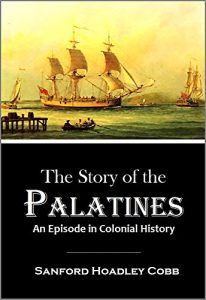Rev Sanford Hoadley Cobb (1838 - 1910) was the author of such books as "The rise of religious liberty in America : a history (1902)" and " The Palatine, or, German immigration to New York and Pennsylvania (1897)".
The German Palatines were early 18th century emigrants from the Middle Rhine region of the Holy Roman Empire, including a minority from the Palatinate which gave its name to the entire group. Towards the end of the 17th century and into the 18th, the wealthy region was repeatedly invaded by French troops, which resulted in continuous military requisitions, widespread devastation and famine. The "Poor Palatines" were some 13,000 Germans who migrated to England between May and November 1709. The English tried to settle them in England, Ireland and the Colonies. The English transported nearly 3,000 German Palatines in ten ships to New York in 1710.
Cobb writes:
"THE reasons for writing this Story of the Palatines are several. Chief among them are these three: that it has never been written in its fulness, or with proper regard to its historic importance; that much of the little which has been written about it abounds in misunderstandings and misstatements; and that the story truly told is one of such intrinsic interest and bears such relation to colonial history as to make it worthy of regard by every student of American society and institutions.
"That which by most people, who know anything about the Palatine Immigration, is supposed to be alluded to in any reference to that people, is merely the incoming of the large company which landed in New York in the early summer of 1710. They made the largest body of emigrants coming at one time to this country in the colonial period. There were nearly three thousand of them, and they were perhaps at once the most miserable and most hopeful set of people ever set down upon our shores.
"But they were not all. A small band had preceded them to New York; about the same time as their own coming, a company of seven hundred had gone to North Carolina, and another company to Virginia; and in later years they were followed by many thousands of their countrymen in the Palatinate, the vast majority of whom found settlement in Pennsylvania. These various immigrations make in reality one story, having, as they do, one source and bound together by a common impulse, constituting a distinct episode in colonial history well worthy of study, and quite unique in its interest and character."
Contents:
I. Introduction
II. The Palatinate. ,
III. The Exodus
IV. The Experiment
V The Failure
VI. The Promised Land .
VII. The Dispersion
Originally published in 1897; reformatted for the Kindle; may contain occasional imperfections; original spellings have been kept in place.
The German Palatines were early 18th century emigrants from the Middle Rhine region of the Holy Roman Empire, including a minority from the Palatinate which gave its name to the entire group. Towards the end of the 17th century and into the 18th, the wealthy region was repeatedly invaded by French troops, which resulted in continuous military requisitions, widespread devastation and famine. The "Poor Palatines" were some 13,000 Germans who migrated to England between May and November 1709. The English tried to settle them in England, Ireland and the Colonies. The English transported nearly 3,000 German Palatines in ten ships to New York in 1710.
Cobb writes:
"THE reasons for writing this Story of the Palatines are several. Chief among them are these three: that it has never been written in its fulness, or with proper regard to its historic importance; that much of the little which has been written about it abounds in misunderstandings and misstatements; and that the story truly told is one of such intrinsic interest and bears such relation to colonial history as to make it worthy of regard by every student of American society and institutions.
"That which by most people, who know anything about the Palatine Immigration, is supposed to be alluded to in any reference to that people, is merely the incoming of the large company which landed in New York in the early summer of 1710. They made the largest body of emigrants coming at one time to this country in the colonial period. There were nearly three thousand of them, and they were perhaps at once the most miserable and most hopeful set of people ever set down upon our shores.
"But they were not all. A small band had preceded them to New York; about the same time as their own coming, a company of seven hundred had gone to North Carolina, and another company to Virginia; and in later years they were followed by many thousands of their countrymen in the Palatinate, the vast majority of whom found settlement in Pennsylvania. These various immigrations make in reality one story, having, as they do, one source and bound together by a common impulse, constituting a distinct episode in colonial history well worthy of study, and quite unique in its interest and character."
Contents:
I. Introduction
II. The Palatinate. ,
III. The Exodus
IV. The Experiment
V The Failure
VI. The Promised Land .
VII. The Dispersion
Originally published in 1897; reformatted for the Kindle; may contain occasional imperfections; original spellings have been kept in place.












